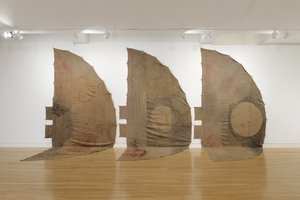This activity is developed for children ages 3 and older. Download and print this guide for easy reference.
Please note that this activity will require assistance from an adult with preparing some food items.
GET INSPIRED
There are many ways to explore works of art. Together, let’s take a closer look at the materials used to make an artwork. This activity features a work from the exhibition Duane Linklater: mymothersside, on view at the Frye Art Museum through January 16, 2022.

Duane Linklater. winter in america_no door_âkamenimok, 2020. Digital print on hand-dyed linen (black tea, sumac, charcoal, cup-and-saucer ochre, iron-red pigment, dandelion), nails. 218 x 312 x 6 in. Courtesy of Catriona Jeffries, Vancouver. Installation view from Duane Linklater: mymothersside, Frye Art Museum, Seattle, 2021. Photo: Jueqian Fang
Artist Duane Linklater used many different natural materials to create dyes and add color to the artwork winter in america_no door_âkamenimok. Can you guess what materials he used to create the colors you see? (Hint: You might be able to find these materials in your kitchen or garden!)
Linklater used black tea, clay, sumac, charcoal, and dandelion. Taking a close look at this artwork, can you guess which color is created by which material?
MAKE SOME ART
Did you know that you might have materials in your own kitchen that you can use to create art? The Frye collaborated with Kathy Hattori of Botanical Colors to create a painting activity using natural materials. Follow along using the video demonstration, or read the instructions below.
You will need:
-
Food items that you can use to create paint, such as:
-
Instant coffee (ground coffee works too but the color won’t be as dark)
-
Curry or turmeric powder
-
Blackberries, blueberries, or raspberries (fresh or frozen)
-
Beet juice (can be found in precooked canned or packaged beets)
-
Powdered greens (usually used for smoothies; can be replaced with cooked and puréed green leafy vegetables with stems removed)
-
Black tea
-
Cayenne pepper, chili powder, paprika
-
Cocoa powder
-
-
Brushes
-
Watercolor paper (or other heavier weight paper, such as cardstock)
-
An old sponge or paper towel
-
Containers for water and mixing paint
-
Charcoal, a black crayon, a black oil pastel, or a black marker
Let’s get started!
-
Choose three food items you’d like to use to create paint for your artwork.
-
Mix each food item with water in their own separate containers to create paint. Start with less water than you think you might need, and add more water as needed. The less water you use, the darker your paint will be.
-
Experiment painting with each color by creating various lines and shapes. Feel free to mix the colors together on your paper to create a new color. Don’t forget to rinse and dry your brush in between colors to avoid mixing colors together in the containers.
-
Once your painting is dry, add in any details, such as lines, shapes, and textures, with charcoal, crayon, oil pastel, or marker.
SHARE YOUR WORK
Once your artwork is complete, take a closer look at it.
-
What do you notice about how the colors change once the paint dries?
-
Are there areas in your painting that are grainy or have a rough texture when you touch it with your fingers? Which natural material created this texture?
-
Are there areas in your painting that appear to be shiny? Which material was it?
-
Did you create any new colors by mixing two or more colors? What colors did you create?
-
Do you notice any scents from the natural materials? What does it smell like?
-
What would you like to title your painting?
We’d love to see your creations! Please share them with us on social media using the hashtag #FryefromHome.
Lynn Chou
Manager of Youth and School Programs